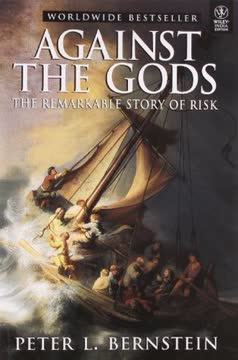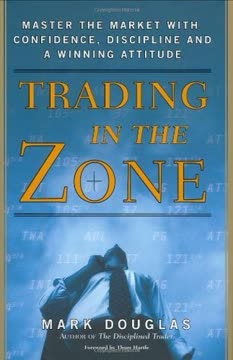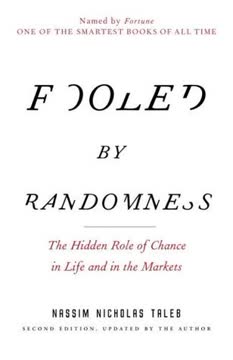نکات کلیدی
1. تسلط بر هنر فروش برای حداکثر کردن سود و حداقل کردن زیان
مبتدیان هرگاه نکتهای مبهم به گوششان میرسد، خرید میکنند. معاملهگران با تجربه میدانند که خرید جدی نیازمند تحقیق جدی است.
فروش حیاتی است. بسیاری از معاملهگران تنها بر خرید تمرکز میکنند و جنبهی به همان اندازه مهم فروش را نادیده میگیرند. تکنیکهای صحیح فروش میتواند به قفل کردن سود و محدود کردن زیان کمک کند. قبل از ورود به معامله، یک استراتژی خروج واضح شامل اهداف سود و سطوح توقف زیان توسعه دهید. این رویکرد تصمیمگیری احساسی را کاهش میدهد و عملکرد کلی معاملهگری را بهبود میبخشد.
استراتژیهای مختلف فروش را در نظر بگیرید:
- فروش در قیمت هدف
- استفاده از توقفهای دنبالهدار برای محافظت از سود
- اجرای خروجهای مبتنی بر زمان
- واکنش به تغییرات در شرایط بازار یا "نویز موتور"
با تسلط بر تکنیکهای مختلف فروش، معاملهگران میتوانند به سناریوهای مختلف بازار تطبیق یابند و نتایج معاملهگری خود را بهینه کنند. به یاد داشته باشید که معاملهگری موفق شامل ورود و خروج مؤثر از موقعیتها است.
2. درک روانشناسی بازار برای پیشبینی روندها و بازگشتها
کفهای بازار سهام تمایل به باریک و تیز بودن دارند، در حالی که سقفها تمایل به گسترده و نامنظم بودن دارند.
رفتار جمعیت بازارها را هدایت میکند. درک روانشناسی بازار برای پیشبینی روندها و بازگشتهای احتمالی ضروری است. تشخیص دهید که ترس و طمع نیروهای احساسی قدرتمندی هستند که حرکات بازار را تحت تأثیر قرار میدهند. ترس تمایل به ایجاد کفهای تیز و ناشی از وحشت دارد، در حالی که طمع اغلب به سقفهای طولانی و نامنظم منجر میشود.
شاخصهای روانشناختی کلیدی:
- شاخصهای احساسات (مثلاً اجماع صعودی، نسبت خرید/فروش)
- شاخص بالاترین-پایینترین جدید
- افراطهای بازار (حرکات پارابولیک، خوشبینی/بدبینی بیش از حد)
- شکستهای کاذب و واگراییها
با مطالعه این عوامل روانشناختی، معاملهگران میتوانند به بینشی در مورد نقاط چرخش احتمالی بازار دست یابند و تصمیمات آگاهانهتری بگیرند. به یاد داشته باشید که بازارها اغلب به دلیل افراطهای احساسی از انتظارات منطقی در هر دو جهت فراتر میروند.
3. استفاده از ابزارهای تحلیل تکنیکال برای تصمیمگیری آگاهانه
میانگینهای متحرک به تعریف منطقه ارزش با ردیابی اجماع عمومی کمک میکنند.
تحلیل تکنیکال الگوها را آشکار میکند. از انواع ابزارهای تکنیکال برای تحلیل روندهای بازار، سطوح حمایت و مقاومت، و نقاط ورود و خروج احتمالی استفاده کنید. میانگینهای متحرک بهویژه به شناسایی مناطق ارزش و جهت روند کمک میکنند. ترکیب چندین شاخص برای تحلیل جامعتر.
ابزارهای تکنیکال ضروری:
- میانگینهای متحرک (مثلاً میانگینهای متحرک نمایی 13 روزه و 26 روزه)
- MACD (همگرایی و واگرایی میانگین متحرک)
- شاخص نیرو
- کانالها و پاکتها
- سطوح حمایت و مقاومت
مهارت در استفاده از این ابزارها برای شناسایی روندها، واگراییها و نقاط بازگشت احتمالی را توسعه دهید. به یاد داشته باشید که هیچ شاخصی به تنهایی بیخطا نیست و ترکیب چندین ابزار میتواند تحلیل قویتری ارائه دهد. همیشه زمینه کلی بازار را هنگام تفسیر سیگنالهای تکنیکال در نظر بگیرید.
4. اجرای استراتژیهای مدیریت ریسک مؤثر
قانون 2% شما را از ریسک کردن بیش از 2% از سرمایه حساب خود در هر معامله منع میکند.
حفاظت از سرمایه خود. مدیریت ریسک مؤثر برای موفقیت بلندمدت در معاملهگری حیاتی است. قوانین سختگیرانهای برای محدود کردن زیانهای احتمالی و حفظ سرمایه معاملاتی خود اجرا کنید. قانون 2% و قانون 6% استراتژیهای مدیریت ریسک بنیادی هستند که به جلوگیری از زیانهای فاجعهبار کمک میکنند.
اصول کلیدی مدیریت ریسک:
- قانون 2%: محدود کردن ریسک در هر معامله به 2% از سرمایه حساب
- قانون 6%: توقف معاملهگری اگر زیانهای ماهانه به 6% از سرمایه حساب برسد
- استفاده از اندازهگیری موقعیت مناسب بر اساس تحمل ریسک
- اجرای دستورات توقف زیان برای محدود کردن زیانهای احتمالی
- تنوعبخشی به معاملات در بازارها یا بخشهای مختلف
با پایبندی به این اصول مدیریت ریسک، معاملهگران میتوانند زیانهای اجتنابناپذیر را تحمل کنند و توانایی بهرهبرداری از فرصتهای آینده را حفظ کنند. به یاد داشته باشید که حفظ سرمایه به اندازه تولید سود مهم است.
5. توسعه یک برنامه معاملاتی جامع و حفظ انضباط
نوشتن یک برنامه بر روی کاغذ تأثیر روانی قدرتمندی بر اکثر افراد دارد. استرس را کاهش میدهد که منجر به افزایش سودآوری میشود.
برنامهریزی موفقیت را به ارمغان میآورد. یک برنامه معاملاتی بهخوبی تعریفشده برای عملکرد مداوم ضروری است. یک برنامه جامع توسعه دهید که استراتژی معاملاتی، قوانین مدیریت ریسک، و معیارهای ورود و خروج خاص شما را مشخص کند. نوشتن برنامه به شما کمک میکند افکار خود را روشن کنید و تصمیمگیری احساسی در طول معاملات را کاهش دهید.
اجزای کلیدی یک برنامه معاملاتی:
- استراتژی معاملاتی کلی و بازه زمانی
- معیارهای ورود و خروج خاص
- قوانین مدیریت ریسک (اندازهگیری موقعیت، سطوح توقف زیان)
- دستورالعملهای مدیریت پول
- روشهای ثبت و ارزیابی عملکرد
با پایبندی دقیق به برنامه معاملاتی خود، انضباط را حفظ کنید. برنامه خود را بهطور منظم بر اساس شرایط بازار و عملکرد خود مرور و بهروزرسانی کنید. به یاد داشته باشید که ثبات و انضباط اغلب از نتایج فردی معاملات مهمتر هستند.
6. یادگیری فروش کوتاه برای سود بردن از کاهش بازار
فروش کوتاه با خرید متفاوت است زیرا روانشناسی جمعیت در سقفها و کفها، در روندهای صعودی و نزولی متفاوت است.
گسترش ابزارهای معاملاتی خود. یادگیری فروش کوتاه به معاملهگران اجازه میدهد از کاهش بازار سود ببرند و بهطور مؤثر فرصتهای خود را دو برابر کنند. ویژگیهای منحصر به فرد فروش کوتاه را درک کنید، از جمله احتمال حرکتهای سریعتر قیمت و نیاز به زمانبندی دقیق.
ملاحظات کلیدی برای فروش کوتاه:
- شناسایی سهام با الگوهای تکنیکال نزولی
- در نظر گرفتن عوامل بنیادی که ممکن است به کاهش قیمت منجر شوند
- آگاهی از علاقه کوتاه و فشارهای کوتاه احتمالی
- استفاده از تکنیکهای مدیریت ریسک مناسب (مثلاً دستورات توقف زیان)
- تشخیص اینکه بازارها در بلندمدت تمایل به صعود دارند
مهارت در تکنیکهای فروش کوتاه را برای تکمیل استراتژیهای معاملاتی بلند خود توسعه دهید. این رویکرد متعادل به شما اجازه میدهد به شرایط مختلف بازار تطبیق یابید و در بازارهای صعودی و نزولی بهطور بالقوه سود ببرید.
7. تطبیق با شرایط متغیر بازار و یادگیری از بازارهای نزولی
درختان به آسمان نمیرسند و بازارهای نزولی به صفر نمیرسند.
انعطافپذیری کلیدی است. شرایط بازار بهطور مداوم در حال تکامل است و معاملهگران موفق باید استراتژیهای خود را بهطور متناسب تطبیق دهند. بازارهای نزولی بهویژه درسهای ارزشمندی در مدیریت ریسک و اهمیت حفظ سرمایه ارائه میدهند. از بازارهای نزولی بهعنوان فرصتهایی برای بهبود مهارتهای معاملاتی خود و شناسایی فرصتهای سرمایهگذاری بلندمدت استفاده کنید.
درسهایی از بازارهای نزولی:
- اهمیت حفظ سرمایه را تشخیص دهید
- شناسایی بخشها و سهامی که قدرت نسبی نشان میدهند
- به دنبال نشانههای کف بازار باشید (مثلاً تسلیم، بدبینی شدید)
- ویژگیهای رالیهای بازار نزولی را درک کنید
- استراتژیهایی برای معامله در بازارهای ناپایدار و نزولی توسعه دهید
با مطالعه و تطبیق با شرایط متغیر بازار، معاملهگران میتوانند عملکرد بلندمدت و مقاومت خود را بهبود بخشند. به یاد داشته باشید که بازارها در چرخهها حرکت میکنند و آماده بودن برای محیطهای صعودی و نزولی برای موفقیت پایدار حیاتی است.
آخرین بهروزرسانی::
FAQ
1. What is Sell and Sell Short by Alexander Elder about?
- Comprehensive selling guide: The book focuses on the art and science of selling stocks and selling short, providing detailed strategies for both exiting long positions and profiting from market declines.
- Psychology and discipline: Elder emphasizes the psychological challenges of selling, the importance of discipline, and the need for structured decision-making and record-keeping.
- Technical and fundamental integration: The book combines technical tools (like moving averages, MACD, Force Index, and the New High-New Low Index) with fundamental analysis to time entries and exits.
- Practical Q&A format: It uses a question-and-answer structure, real trade examples, and lessons from bear markets to prepare readers for real-world trading challenges.
2. Why should I read Sell and Sell Short by Alexander Elder?
- Unique focus on selling: Unlike most trading books that focus on buying, Elder’s book fills a critical gap by teaching when and how to sell, which is essential for preserving profits and managing risk.
- Master short selling: The book demystifies short selling, explaining its mechanics, risks, and advantages, and encourages traders to become comfortable with profiting from declines.
- Proven systems and methods: Elder presents tested methods like the Triple Screen system, Impulse system, SafeZone stops, and the New High-New Low Index, all designed to help traders make objective decisions.
- Lessons from real markets: Insights from historical bear markets, especially 2007-2009, show how to apply the book’s principles in volatile conditions.
3. What are the key takeaways from Sell and Sell Short by Alexander Elder?
- Selling is as important as buying: Knowing when and how to sell is crucial for aligning with market cycles and protecting capital.
- Risk management is foundational: The 2% and 6% rules, position sizing, and stop placement are central to Elder’s approach to risk control.
- Trading psychology matters: Emotional discipline, self-care, and record-keeping are vital for long-term trading success.
- Technical tools guide decisions: Indicators like MACD, Force Index, and the New High-New Low Index help confirm trends and signal reversals.
4. What are the best quotes from Sell and Sell Short by Alexander Elder and what do they mean?
- "The area least covered in trading literature was selling." Elder highlights the lack of focus on selling in most trading education, underscoring the book’s unique value.
- "Size does not matter. What matters is risk." This quote emphasizes that controlling risk is more important than the size of a trade.
- "I am a professional—I sell hope." Quoted from a market maker, this reflects the reality that most option buyers lose money, while sellers profit from time decay.
- "The single most important factor in your long-term success or failure is the quality of your records." Elder stresses the critical role of detailed record-keeping in trading improvement.
5. How does Alexander Elder explain the importance of selling and short selling in trading?
- Selling is a hard business: Elder compares selling to a difficult but necessary task, requiring discipline and realism rather than hope and optimism.
- Markets move in cycles: Understanding that prices must fall as well as rise, Elder teaches that selling is essential to align with market rhythms.
- Short selling doubles opportunities: Professionals use short selling to profit from declines, and Elder encourages traders to master this skill after learning to sell long positions.
- Overcoming psychological barriers: Many traders fear shorting, but Elder provides clear explanations and analogies to help readers become comfortable with it.
6. What are the "Three Great Divides" in trading according to Sell and Sell Short by Alexander Elder?
- Technical vs. Fundamental Analysis: Fundamentalists study company values and supply-demand, while technicians focus on price patterns and indicators, believing price reflects all known information.
- Trend vs. Counter-Trend Trading: Trend traders ride long directional moves, while counter-trend traders capitalize on market oscillations and reversals, each style suiting different temperaments.
- Discretionary vs. Systematic Trading: Discretionary traders interpret charts and make real-time decisions, whereas systematic traders rely on pre-designed, backtested systems to generate signals.
7. How does Sell and Sell Short by Alexander Elder address trading psychology and emotional discipline?
- Mind as a trading tool: Emotions, hopes, and fears directly affect trading decisions; successful traders isolate themselves to make independent, unbiased choices.
- Discipline and self-care: Elder advises traders to treat themselves well, celebrate successes, and avoid trading when in a foul mood to maintain a calm, focused mindset.
- Addiction and temperament risks: Those with poor impulse control or substance issues are unlikely to succeed; trading requires emotional stability and a genuine love for the process.
- Avoiding regret and greed: Elder warns that regret and greed can sabotage trading, leading to overstaying trades or chasing profits.
8. What are the 2% and 6% risk management rules in Sell and Sell Short by Alexander Elder?
- 2% Rule: Never risk more than 2% of your account equity on a single trade to avoid devastating losses that can ruin confidence and capital.
- 6% Rule: Stop trading for the rest of the month if cumulative losses reach 6% of your account, preventing a series of losses from destroying your account.
- Available Risk concept: Before entering a trade, calculate if the 6% monthly loss limit allows it, considering current losses and risk on open trades.
- Risk over trade size: Elder emphasizes that controlling risk is more important than the size or cost of a trade.
9. How does Alexander Elder recommend setting stops and managing trade exits in Sell and Sell Short?
- Hard vs. soft stops: Hard stops are orders placed in the market; soft stops are mental levels for discretionary exits, with hard stops recommended for beginners.
- Stop placement strategies: Avoid placing stops just below the latest low to prevent being stopped out by whipsaws; use methods like "Nic’s stop" or SafeZone stops to filter noise.
- Trailing stops and adjustment: Use trailing stops (Parabolic, SafeZone, Volatility-Drop) to protect profits and stay in trends, only moving stops in the direction of the trade.
- Balancing risk and reward: Wider stops require smaller position sizes, while tighter stops risk more frequent stop-outs; balance stop width with volatility and trade objectives.
10. What is the "Iron Triangle" of risk control in Sell and Sell Short by Alexander Elder?
- Three components: The Iron Triangle consists of risk per share (distance from entry to stop), total permitted risk per trade (based on money management rules), and position size (number of shares to trade).
- Position sizing based on risk: Position size is calculated by dividing total risk allowed by risk per share, ensuring losses stay within acceptable limits.
- Risk over size: Elder stresses that risk control is more important than trade size, helping traders avoid catastrophic losses.
- Practical application: This method ensures that every trade fits within the trader’s overall risk management plan.
11. How does Alexander Elder use technical indicators like the New High-New Low Index and MACD in his trading systems?
- New High-New Low Index (NH-NL): Elder considers NH-NL the best leading indicator for market health, confirming trends and warning of tops and bottoms through divergences.
- MACD and Force Index: These indicators help identify momentum shifts and trend reversals, with bearish divergences signaling tops and bullish divergences signaling bottoms.
- Impulse system: This system colors bars to indicate buy, sell, or stand aside signals, guiding trading actions and censoring impulsive trades.
- Multi-timeframe analysis: Elder recommends making strategic decisions on weekly charts and tactical decisions on daily charts, aligning timing and risk management.
12. What practical lessons and advanced strategies does Sell and Sell Short by Alexander Elder offer for trading in bear markets and non-equity instruments?
- Bear market strategies: Elder highlights the importance of swing trading—shorting rallies and covering near oversold zones—rather than holding shorts throughout a bear market.
- Asymmetry of tops and bottoms: Bear markets have sharp, panic-driven bottoms and broad, drawn-out tops, affecting stop placement and trade management.
- Shorting in futures and forex: Shorting is integral in these markets, with unique risks and mechanics compared to stocks; Elder warns about the dangers of high leverage and broker practices in forex.
- Options writing: Elder differentiates between covered and naked options writing, advising beginners to understand the risks and discipline required before engaging in naked writing.
نقد و بررسی
کتاب فروش جدید و فروش کوتاه بهطور کلی نقدهای مثبتی دریافت کرده است و خوانندگان از توضیحات واضح آن در مورد استراتژیهای معاملاتی و روانشناسی بازار قدردانی میکنند. بسیاری این کتاب را برای معاملهگران نوسانی و افرادی که به دینامیک بازار علاقهمندند، ارزشمند میدانند. برخی اشاره میکنند که مطالب آن مشابه کتابهای قبلی الدر است. منتقدان به بینشهای الدر در زمینه فروش، فروش کوتاه و مدیریت ریسک توجه دارند. در حالی که برخی آن را برای معاملهگران فعال عالی میدانند، دیگران تحلیلهای فنی را برای نیازهای خود بیش از حد پیچیده مییابند. بهطور کلی، خوانندگان این کتاب را برای کسانی که به دنبال کسب سود از نوسانات قیمت کوتاهمدت هستند، توصیه میکنند.
Similar Books
















